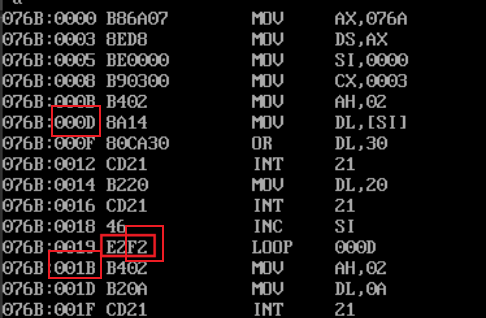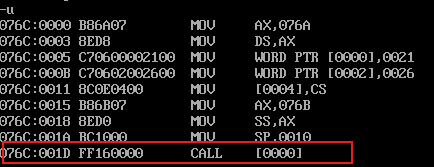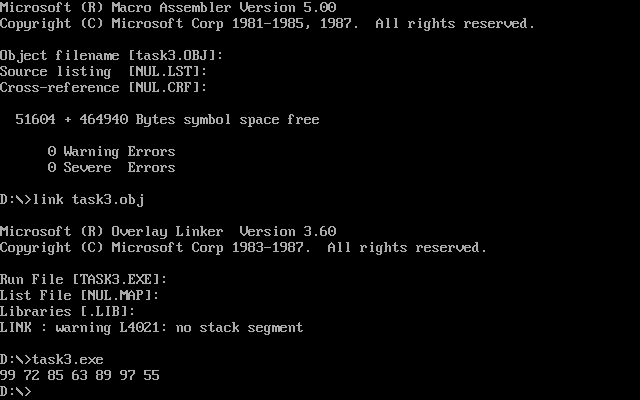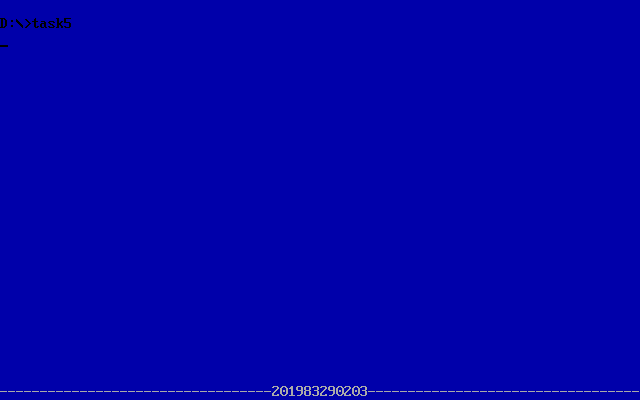IV. experimental summary
1. Experimental task 1
- The source code of the program is as follows
assume cs:code, ds:data data segment x db 1, 9, 3 len1 equ $ - x y dw 1, 9, 3 len2 equ $ - y data ends code segment start: mov ax, data mov ds, ax mov si, offset x mov cx, len1 mov ah, 2 s1:mov dl, [si] or dl, 30h int 21h mov dl, ' ' int 21h inc si loop s1 mov ah, 2 mov dl, 0ah int 21h mov si, offset y mov cx, len2/2 mov ah, 2 s2:mov dx, [si] or dl, 30h int 21h mov dl, ' ' int 21h add si, 2 loop s2 mov ah, 4ch int 21h code ends end start
- The screenshot of the operation is as follows
-
- Answer question ①
-
line27, Assembly instruction loop s1 When jumping, it jumps according to the displacement. adopt debug Disassemble, check its machine code, and analyze the displacement of its jump? (the displacement value is answered in decimal) CPU Angle, description How to calculate the post jump label s1 The offset address of the subsequent instruction.
- The disassembly results are as follows
- The jump displacement is 14
- The method of calculating the offset address of the instruction after the jump label s1 is as follows
- Observe the machine code E2F2 corresponding to the Loop command
- An assembly statement will correspond to a machine code, which is divided into two parts
- Assembly instructions correspond to the first two hexadecimal numbers
- The number of hexadecimal digits after the operand
- For loop, the operand is the difference between the address of the beginning of the loop and the address of the next instruction of the loop instruction, and is presented in the form of complement
- Therefore, the formula can be obtained
- The address at the beginning of the loop = the address of the next instruction of the loop instruction + the difference between the addresses
- An assembly statement will correspond to a machine code, which is divided into two parts
- According to the formula, the offset address of the instruction after the jump label s1 needs to be solved, and two information needs to be known
- loop instruction the address of the next instruction
- The operand of the loop instruction machine code
- In this question
- The address of the next instruction of the loop instruction is 001B, which is 27 when converted to decimal
- The operand of the loop instruction machine code is F2 (complement), i.e. 11110010 (complement). The original code is 10001110, which is converted to decimal - 14
- Therefore, the address at the beginning of the cycle is 27 + (- 14) = 13, that is, 000D
- The above is how the CPU calculates the location of the instruction after s1
- Observe the machine code E2F2 corresponding to the Loop command
-
- Answer question ②
- Similar to question ①, first observe the result of disassembly
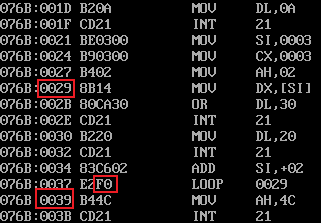
- Calculate two numbers
- The position of the next instruction of the loop instruction is (0039) 16 = (57) 10
- The operand of the loop instruction machine code is F0, that is, 11110000, and the original code is 10010000, that is - 16
- 57-16=41, (41)10=(29)16
- After calculation, the result is the same as that of disassembly
- The above is the process of the CPU calculating the instruction position after s2
2. Experimental task 2
- The program source code is as follows
-
1 assume cs:code, ds:data 2 3 data segment 4 dw 200h, 0h, 230h, 0h 5 data ends 6 7 stack segment 8 db 16 dup(0) 9 stack ends 10 11 code segment 12 start: 13 mov ax, data 14 mov ds, ax 15 16 mov word ptr ds:[0], offset s1 17 mov word ptr ds:[2], offset s2 18 mov ds:[4], cs 19 20 mov ax, stack 21 mov ss, ax 22 mov sp, 16 23 24 call word ptr ds:[0] 25 s1: pop ax 26 27 call dword ptr ds:[2] 28 s2: pop bx 29 pop cx 30 31 mov ah, 4ch 32 int 21h 33 code ends 34 end start
- Problem: according to the jump principle of call instruction, theoretically, before the program is executed and exits (line31), register ax=?, bx=?, cx=?
- The thinking process is as follows
- First, you need to know the function of the call instruction
- Press the address of the next instruction of the program into the stack (that is, press the address in the program counter pc into the stack)
- Execute the instruction of the address marked after call (change the value in pc to the address after call)
- Put the data in ds:[2] into the pc in this question
- The role of call word ptr a
- Push the address of the next instruction onto the stack
- jump to the address of the following label a
- call dword ptr a
- Press the segment address and intra segment offset of the next instruction into the stack in turn
- jump to the address of the following label a
- Second, you need to understand the program
- data segment and stack segment define a series of data
- The program to be executed is written in code segment
- line13-14: send the address value of data segment into ds
- line16: sends the address of the code segment s1 to ds:[0] and ds:[1] for later calls.
- line17: sends the address of the code segment s2 to ds:[2] and ds:[3] for later calls.
- line18: enter the address of cs into ds:[4]
- line20-22: set stack bottom and top pointers
- line20-21: send the address value of stack segment into ss, indicating that the address at the bottom of the stack is the address pointed to by stack segment
- line22: send 16 to sp, indicating that the position of the top element of the stack is ss:sp
- line24: call the instructions in ds:[0] and ds:[1], which are divided into two stages
- Push the offset address in the segment where the next instruction is located into the stack
- Set the value of pc to the data in ds:[0]
- line25: pop up the stack top element and store it in ax
- Because line24 has a stack operation just now, the content just pressed in should pop up at this time, that is, the address of s1
- line27: call the corresponding instructions in ds:[2],ds[3],ds:[4],ds:[5], which is divided into two stages
- Press the segment address and offset address of the next instruction into the stack in turn
- Set the value of pc to the data in ds:[2]
- line28: pop up the stack top element and store it in bx
- Just now line27 presses the segment address and the intra segment offset of the address where the s2 code segment is located into the stack in turn, so the top of the stack is the offset address of s2
- line29: pop up the stack top element and store it in cx
- At this time, the top element of the stack is the segment address of s2
- While reading the program, I know the answer to the question
- Because cs:ip points to the address of the currently executing code, the
- ax stores the intra segment offset address part of the address of s1 code segment, that is, the value in the ip register when call word ptr ds:[0] is executed
- bx stores the intra segment offset address part of the address of the s2 code segment, that is, the value in the ip register when call dword ptr ds:[2] is executed
- The segment address part of the address of the s2 code segment is stored in cx, that is, the value stored in cs when call dword ptr ds:[2] is executed
- Because cs:ip points to the address of the currently executing code, the
- First, you need to know the function of the call instruction
- Practical verification
- First look at the disassembly results
- View the address of the call instruction, 001d
- Run the program to the call word ptr ds:[0] command, and the operation is completed
- The value of ax is indeed the value of ip 0021
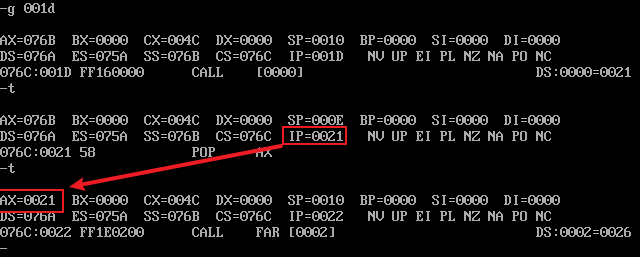
- Run the program to the call dword ptr ds:[2] command. The operation is completed
- The value of bx is indeed the value of ip
- The value of cx is indeed the value of cs
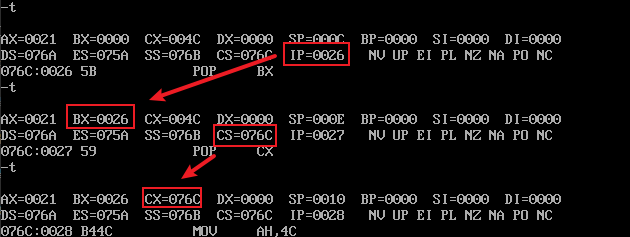
- View the address of the call instruction, 001d
- After verification, this question ends
- First look at the disassembly results
3. Experimental task 3
- At the beginning of the experiment, you need to know the following information
- Memory principle for outputting characters on the screen
- Numerical values are stored in the computer in binary form
- If the value 12666 is stored in the computer, it is 0011000101111010B(317AH)
- The computer can understand this string of data
- The numbers we see printed on the screen are presented in ASCII code
- For example, the value 12666, if you want them to be displayed on the screen, the storage in the computer should be 31H,32H,36H,36H,36H
- If you want to see the value on the screen, you should convert the binary number in the computer to its corresponding ASCII code
- ASCII code only defines the representation corresponding to 0-9
- Therefore, when processing values, they should be processed bit by bit
- For example, if the value is 12666, take one bit (divide by ten to get the remainder), turn it into character 6, then process 1266, and so on
- Numerical values are stored in the computer in binary form
- Assembly instructions for outputting characters on the screen
- The instruction int 21h is a multifunctional instruction
- During execution, the value of register AH will be checked first, and different operations will be carried out according to different values
- When AH=02H, output the characters in DL to the screen
- During execution, the value of register AH will be checked first, and different operations will be carried out according to different values
- The instruction int 21h is a multifunctional instruction
- About division instructions
- div instruction is a division operation instruction
- Instruction format
- div register
- Instruction operation process (take div bx as an example)
- The dividend is placed in register AX
- The divisor is stored in the register following the instruction div
- The supplier is stored in AL
- The remainder is placed in AH
- Method for converting numbers to corresponding ASCII codes
- ASCII code corresponding to decimal digit character = decimal digit value + 30H
- Memory principle for outputting characters on the screen
- With the above information, begin to conceive the problem
- Title restatement
- Seven two digit decimal numbers are stored in the memory and need to be printed on the screen
- thinking
- The values stored in the memory need to be printed on the screen
- So you need to convert these 7 numbers bit by bit into ASCII code
- Taking 99 as an example, the steps of operating on a number are as follows
- Take out a digit number -- 9
- Convert 9 to its corresponding ASCII code (above the formula)
- Printout
- Take out ten digits -- 9
- Convert 9 to its corresponding ASCII code '
- Printout
- For the above steps, perform the following operations (PrintNumber)
- Carry out 99 / 10 operation. (the remainder obtained is stored in AH by default)
- Carry out "+ 30H" operation on AH, and use the formula to calculate the ASCII code value corresponding to the remainder
- Store the calculated ASCII code value in dl for output
- Output with int 21
- Repeat operations 1, 2 and 3 to output ten digits
- Complete a digital output
- Printing spaces is relatively simple and will not be repeated
- The values stored in the memory need to be printed on the screen
- code implementation
-
1 assume cs:code, ds:data 2 3 data segment 4 x db 99, 72, 85, 63, 89, 97, 55 5 len equ $- x ;Align the current location with x Position difference len in,len=7 6 data ends 7 8 code segment 9 start: 10 mov ax, data ;take x Start address of si in 11 mov ds, ax 12 mov si, offset x 13 mov cx,len 14 15 s1: call printNumber 16 call printSpace 17 inc si 18 loop s1 19 20 mov ah, 4ch 21 int 21h 22 printNumber: 23 mov ah,00 24 mov al, ds:[si] ;take si The value corresponding to the address is put into ax in,Act as divisor.For division 25 mov bl, 10 ;Put 10 in bx in,Act as divisor,For division 26 div bl ;division 27 or al, 30h ;General quotient(Ten digit part of the original value)Turn to corresponding ASCII Code value 28 mov dl, al ;Corresponding to the value of quotient ASCII Value put dl in,For output 29 30 or ah, 30h ;Remainder(Bit part of the original value)Turn to corresponding ASCII Code value 31 mov bh,ah ;Remainder(Bit part of the original value)Turn to corresponding ASCII Code value stored in bh in,Because it needs to be modified below ah Value of,by int 21h Prepare,So we have to put it somewhere else first 32 33 mov ah,2 34 int 21h ;Output ten digits of the original value 35 36 mov dl, bh 37 mov ah,2 38 int 21h ;Output bit 39 40 ret ;Returns the place where the function was called 41 42 printSpace: 43 mov dl,' ' ;Move empty characters into dl in,For output 44 mov ah,2 45 int 21h 46 ret 47 48 49 code ends 50 end start
-
- The operation results are as follows
- Title restatement
-
4. Experimental task 4
- Before the experiment, we need to know the following information
- There is a special area in the memory address space into which writes are immediately displayed on the screen
- The address range of this area is B8000H-BFFFFH
- The area name is 80 * 25 color character mode display buffer
- It is generally expressed in the form of B800:0000
- The characteristics of 80 * 25 color character mode display buffer are as follows
- A character occupies two bytes of space (generally, one character occupies one byte)
- In the occupied byte, the upper eight bits are color information and the lower eight bits are ASCII code

- According to the above characteristics, you can write
- It is written in green on a red background, and the upper eight digits are 01000010B
- White characters on black background, eight digits high, 00000111B
- Red letter on black background, with eight high digits of 00000100B
- Green characters on black background, eight digits high, 00000010B
- Line information
- Each line has 80 characters. Because a character in this space occupies two bytes, a line occupies a total of 160 bytes
- The offset address of the first line is 000-009F
- The offset address of the second line is 0A0-13F
- And so on, the offset address of the last line is F00-F9F
- Each line has 80 characters. Because a character in this space occupies two bytes, a line occupies a total of 160 bytes
- There is a special area in the memory address space into which writes are immediately displayed on the screen
- With the above information, begin to conceive the code of this problem
- Title restatement
- The red character string on a black background is displayed at the top of the screen, and the green character string on a black background is displayed at the bottom of the screen
- thinking
- To display a colored string, you need to write data to B8000-BFFFF
- The string is displayed at the top, and data needs to be written from B800:0000
- The string is displayed at the bottom. You need to write data from B800:0F00
- The written data should be an ASCII code + a display information, cyclic input
- With ideas, the code is very easy to write. The code is as follows
1 assume cs:code, ds:data 2 data segment 3 str db 'try' 4 len equ $- str 5 data ends 6 7 code segment 8 start: 9 mov ax,data 10 mov ds,ax 11 12 mov si,offset str 13 mov cx, len 14 mov bl, 00000010B ;Save color information---Black background green 15 mov bp, 00 ;Save the position of the first line 16 mov ax, 0B800H ;80*25 Segment address of color character display area 17 mov es, ax 18 19 s1: call printStr 20 loop s1 21 22 mov bl,00000100B ;Save color information---Red on black background 23 mov bp,0F00H ;Save position of last line 24 mov cx,len ;Set the number of cycles 25 mov si,offset str 26 27 s2: call printStr 28 loop S2 29 30 mov ah, 4ch 31 int 21h 32 33 34 printStr: 35 mov ax, ds:[si] 36 mov es:[bp],ax 37 inc bp 38 inc si 39 mov es:[bp],bl 40 inc bp 41 42 ret 43 44 45 code ends 46 end start
- The operation results are as follows
- Title restatement
- Before the experiment, we need to know the following information
-
5. Experimental task 5
- The basic knowledge part is the same as experimental task 4. The difficulty of this problem is to calculate the starting position of student number string
- Because one line can display 80 characters, our student number has 12 characters
- To display the student number in the middle, you need to leave (80-12) / 2 = 34 characters on the left
- These 34 characters occupy 2 bytes per character in the 80 * 25 color character display space
- So it takes up 68 bytes, that is, 44H bytes
- The offset address at the beginning of the last line is 0F00H, so the offset address at the beginning of the student number is 0F44H
- The program design idea is as follows
- The whole consists of three cycles
- The loop turns the screen to a blue background
- The loop makes the last line a horizontal line (minus sign)
- Loop so that the student number is displayed in the middle of the last line
- The whole consists of three cycles
- With ideas, the program design is very simple
- s1 corresponds to the first cycle
- s2 corresponds to the second cycle
- s3 corresponds to the third cycle, and the code is as follows
1 assume ds:data, cs:code 2 data segment 3 stu_no db '201983290203' 4 len equ $ - stu_no 5 data ends 6 7 code segment 8 start: 9 mov ax,data 10 mov ds,ax 11 12 mov si,offset stu_no 13 14 mov cx,2000 15 16 mov bl,00010000B 17 mov ax,0B800H 18 mov es,ax 19 mov bp,00 20 21 s1: inc bp 22 mov es:[bp],bl 23 inc bp 24 loop s1 ;s1 Cycle sets the interface to blue 25 26 mov bp,0F00H 27 mov bl,00010111B 28 mov cx,80 29 30 s2: mov ax, 45 ;Horizontal line/Minus sign ASCII Code 45 31 mov es:[bp], ax 32 inc bp 33 mov es:[bp],bl 34 inc bp 35 loop s2 36 37 mov ax,data 38 mov ds,ax 39 mov si,offset stu_no 40 mov bp,0F44H 41 mov cx, len 42 43 s3: mov ax, ds:[si] 44 mov es:[bp],ax 45 inc si 46 inc bp 47 mov es:[bp],bl 48 inc bp 49 loop s3 50 51 code ends 52 end start
- The operation results are as follows
- The basic knowledge part is the same as experimental task 4. The difficulty of this problem is to calculate the starting position of student number string
- Experience has been given in detail in the blog, thank you!

